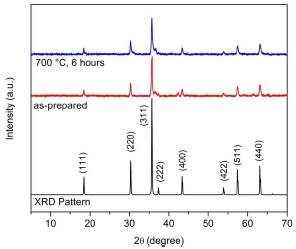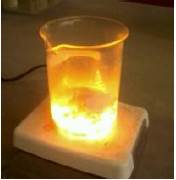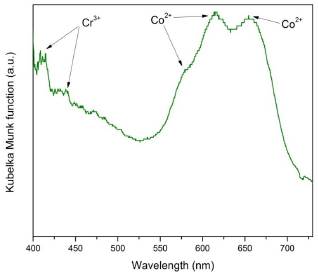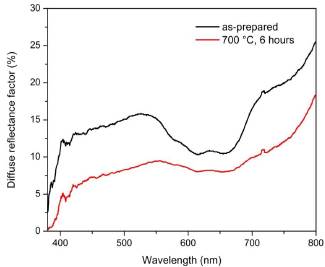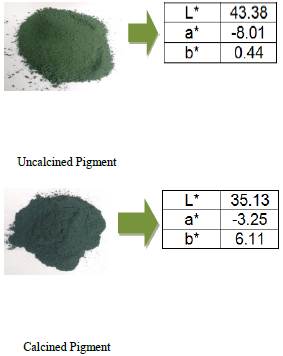1. Introduction
Ceramic pigments are inorganic compounds which are used in ceramic industry for coloring ceramic bodies and vitreous coatings deposited on ceramic surfaces, therefore they should be stable to calcination temperatures in the formation of ceramic materials or enamels, depending on the associated specific application. Additionally, they must have a good chemical resistance with the compounds in which it interferes [1], for this the Color Pigment Manufacturers Association of United States of America, Dry Color Manufacturer's Association (DCMA), have classified the main structures used in the ceramic industry [2], among which a family with a good range of tones can be found, known as spinel structures. Amongst these spinel structures is the CoCr2O4 responsible for the green color in ceramic products.
Spinels are cubic crystal structures with chemical formula AB2O4, receive the name of the spinel mineral MgAl2O4, a well-known structure in the inorganic world, in which there is a compact cubic stacking of Oxygen ions with Mg2+ and Al3+ ions occupying the tetrahedral and octahedral holes, respectively, of which there are 64 tetrahedral and 32 octahedral places, and only 8 tetrahedral and 16 octahedral holes occupied by the A2+ and B3+ cations, respectively, in the type 2-3 spinels [3]. Currently there is a great interest in finding new synthesis routes that enable the obtention of inorganic powders at low temperatures, since in their traditional production of solid state reaction the raw materials used, such as oxides, carbonates and sulphates are in solid phase and so the employed temperatures are above 1000°C and reaction times are over 24 hours; this in order to improve the mass transfer and the kinetics of the chemical reaction for the formation of the compound, which is reflected in a high energy expense that increases the production costs of such compounds [5].
For this reason, new synthesis routes have been sought, that allow to obtain inorganic pigments at process temperatures and times below 1000°C and 24 hours respectively [6]. Among these stand out the synthesis method using a polymeric precursor [7], the solvothermal assisted microemulsion route [8], aerosol pyrolysis [9], the solution combustion synthesis [10], and so on. Is important to analyze the solution combustion synthesis method, since is characterized for having a simple experimental setup [11] and because is a process that lasts only for a few minutes [12], besides the possibility of obtaining the desired phase in one stage, without the need of subsequent calcinations, where the initial solution for the desired precursors is made with water as solvent. Its performance is due to the fact that when the ignition temperature for an oxidant/reducing mixture, the energy released by the reaction allows to achieve high temperatures that enables the formation of the desired phase.
In this investigation is reported the synthesis of green inorganic pigment with CoCr2O4 spinel structure using the solution combustion synthesis method, which presents an advantage versus the industrial method, since it employs a temperature below 1000°C and times below 24 hours.
2. Solution Combustion Synthesis
The CoCr2O4 spinel structure is synthetized by solution combustion synthesis method. To obtain 0.013 mol of the structure, the following precursors were used as oxidant agents: Cobalt nitrate hexahydrate Co(NO3)2*6H2O (J.T. Baker, 99% purity) and Chromium nitrate nonahydrate Cr(NO3)3*9H2O (R.A. Chemicals, 99% purity), and as a reducing agent Glycine fuel NH2CH2COOH (Panreac, 99% purity). Previous calculations were performed using the stoichiometric equation (1), in order to obtain a full combustion reaction.
Initially, precursors were weighted and transferred to a borosilicate vitreous container of 1000 ml and added 25 ml of deionized water in agitation during 10 minutes until a solution is formed. Then the temperature of the hot plate was increased up to 90°C for a slow evaporation of water until the formation of the system as a precursor gel, which contains the oxidant and reducing agents. The gel was slowly heated until a temperature of 200°C was achieved where the combustion reaction started, which indicates that the ignition temperature was reached, and the formation of a flame in a time below 30 seconds was observed, which show a rapid reaction. The powder obtained was also calcinated at 700°C for a period of 6 hours, with the purpose of observing if the phase was stable up until said temperature, and to eliminate organic matter in case the combustion would not have been completed.
3. Characterization
The crystal structures of the obtained powder after combustion and of the calcinated powder were determined using a double-circuit multipurpose X-Ray diffraction equipment Xpert-Pro PANanalytical with Cu-Kα (λ=0.15406 nm), in a diffraction interval of 10-70° (2θ), and at a pass of 0.026° per second; Obtained results were analyzed using XPertHighScore software, which has a diffraction pattern database. Morphological analysis was realized using a JEOL Scanning Electron Microscope with field emission, with reference JSM-6701F, operating voltage of 12kV and 10n.A electrical current for image generation.
Analysis for visible spectrophotometry and colorimetric coordinates CIE L*a*b* were performed in an 0cean0ptics 2000 UV-VIS spectrophotometer with spectral range between 200 and 1110 nm. The bidirectional measurement geometry 45°:0° was employed, CIE D65 illuminant and a 10° standard observer. Colorimetric coordinates L* between 0-100 indicate clarity of the sample, where 100 is the maximum and 0 is the minimum, in the case of a*(+) for red and a*(-) for green, finally b*(+) for yellow and b*(-) for blue, according to the ASTM E308-13 norm.
4. Result and Discussion
Figure 1 shows the X-ray diffractograms of the CoCr2O4 spinel structure for the obtained samples through solution combustion before and after calcination. Is important to observe that all the peaks in the diffraction of the expected spinel structure with JCPDS 22-1084 are present in both powders. The CoCr2O4 structure belongs to the cubic crystal system with spatial group Fd3m, and spatial group number 227. Also, in the case of the uncalcined sample a peak is present at 2θ=42,5° associated to a secondary phase of Cr2O3 JCPDS 01-080-1668, which can be explained as follows: even though the conditions for the synthesis were near the temperature reached during combustion, this is probably due to the fact that the gel was not completely homogenized.
This has been reported in [13], when citric acid is used as fuel but when the calcination is performed, said peak disappears, which indicates the formation of the pure phase at 700°C and 6 hours, and the thermal stability of the phase. The lattice parameter for the structure is estimated using the equation that relates the parameter with the main diffraction planes and the angle diffracted by the plane, where a is the cell's lattice parameter, 1 is the wavelength of the used X-radiation, λ=0.15406 nm, the main plane is (311) and the plane's diffraction angle is 2θ=35.71°.
The calculated lattice parameter is a=0.833 nm, which is similar to the value reported by Younis et. al. of a=0.832 nm [13], when CoCr2O4 is synthesized using solution combustion method using citric acid as fuel and calcinating the obtained powders after the combustion at a temperature of 650°C for 2 hours. Furthermore, the average crystallite size for the calcinated powder was of 2566 nm, calculated using Scherrer's formula:
Here D is the average crystallite size, λ is the X-ray wavelength, β is the Full Width at Half-Maximum (FWHM) of the diffraction peak and θ is Bragg's diffraction angle, in degrees. This value is very similar to the one previously reported of D = 26.66 nm from powder obtained by combustion solution with citric acid [13].
Figure 3 presents the images of the Scanning Electron Microscope by field emission for the synthesized powders. Presence of pores is observed. This has been reported by other researchers [14], which is the result of the release of gases formed during the combustion reaction.
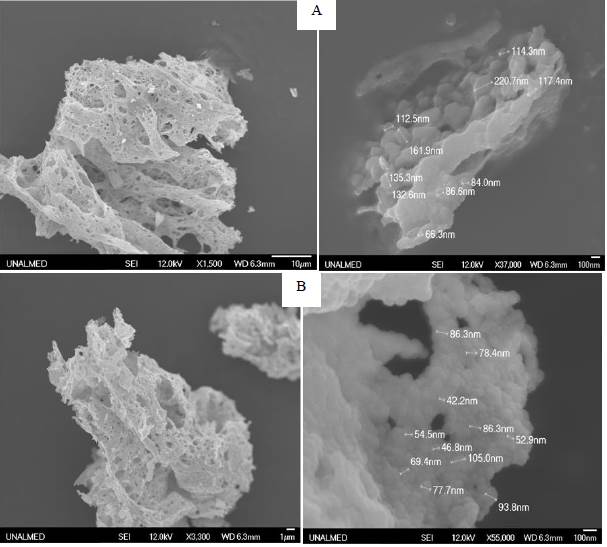
Figure 3 Images of Scanning Electron Microscope by Field Emission for: (A) Uncalcined CoCr2O4; (B) CoCr2O4 after calcination.
Additionally, particle agglomerations were found, which indicates the existence of a synthesis process due to the combustion temperature. Is also observed that calcination shows no apparent change in the microstructure.
In figure 4 the absorption spectra for CoCr2O4 is shown, and in figure 5 the diffuse reflectance spectra for the CoCr2O4 structure in the visible region from 400nm to 700nm, which show an absorption band between 570nm and 670nm, attributed to allowed electronic transitions per spin 4A2 (F)→4T1 (P) when the Co2+ cation is in tetrahedral positions of the spinel structure [15].
Additionally absorption bands are found between 400nm and 440nm, associated to allowed electron transitions per spin 4A2g →4T2g when the Cr3+ cation is in octahedral positions in the spinel structure as previously reported [16]. Furthermore, a wide band of reflectance is observed between 470nm and 570nm, pointing out the green color in the obtained samples. Also, after calcination is observed that the sample presents a smaller reflectance factor in the entire spectrum, which can be associated to the change in dispersion of visible electromagnetic radiation that could be linked to microstructural changes.
Figure 6 presents the values for the colorimetric coordinates corresponding to the powders before and after calcination. Is also shown that the clarity coordinate L* decreases when powder calcination occurs, which is observed as well in the diffuse reflectance spectra and is possibly associated to the change in the spinel inversion, since the Co2+ and Cr3+ cations can swap tetrahedral and octahedral positions. Also, the colorimetric coordinate a* is still negative, indicating that the samples are green, and in the case of the b* coordinate is observed that there is an increase after calcination, which indicates that the sample has turned yellower.
The color coordinates L* = 34.65, a* = -10.43 and b* = -2.78 for the CoCr2O4 green pigment have been reported for powders obtained by solution combustion using oxalic acid as fuel by Chamyani et. al. [17], which are different to the coordinates obtained in this research. This is due to the differences in the synthesis parameters such as fuel type and differences in dispersion of visible radiation, since they can present variations in the powder morphology, for example porosity or different agglomerations.
5. Conclusions
Inorganic green CoCr2O4 pigment was synthesized by solution combustion using glycine as fuel in one stage with the presence of a secondary phase, which disappears when performing the calcination at 7000°C for 6 hours. This was confirmed by XRD. The microstructure showed there is porosity and particle agglomeration as consequence of the combustion reaction.
Spectroscopy in visible range enables to find the absorption bands associated to the Cr3+ and Co2+ cations which allow to obtain green powders. The lattice parameter for the structure is a = 0.833 nm and the average crystallite size is 25.66 nm, which are similar values to those previously reported for solution combustion synthesis method using citric acid as fuel. Additionally, the color coordinates L* = 35.13, a* = -3.25 and b* = 6.11 indicate the powder's green color.














